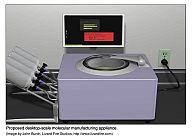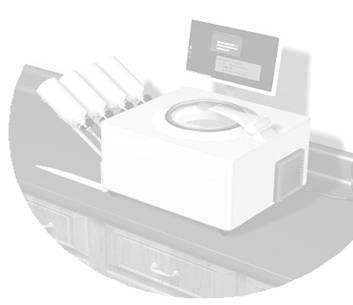














Results of Our Ongoing Research
These pages, marked with GREEN headings, are published for comment and criticism. These are not our final findings; some of these opinions will probably change. LOG OF UPDATES
CRN Research: Overview of Current Findings
- Timeline for Molecular Manufacturing
- Personal Nanofactories (PNs) ◄ YOU ARE HERE
- Products of Molecular Manufacturing
- Benefits of Molecular Manufacturing
- Dangers of Molecular Manufacturing
- No Simple Solutions
- Administration Options
- The Need for Early Development
- The Need for International Development
- Thirty Essential Nanotechnology Studies
Personal Nanofactories (PNs)
A short video has been produced using computer animation to assist in visualizing nanosystems and molecular manufacturing. Productive Nanosystems: from Molecules to Superproducts is a collaborative effort of animator and engineer John Burch and pioneer nanotechnologist Dr. K. Eric Drexler, made possible through a challenge grant from Mark Sims and NanoRex. The four-minute film depicts an animated view of a nanofactory and demonstrates key steps in a process that converts simple molecules into a billion-CPU laptop computer.
NOTE: This page is a summary of, and permanent link to, a CRN authored paper originally published in the peer-reviewed Journal of Evolution and Technology. The paper can be viewed for free online, and is also available for purchase in a bound, hardcopy format.
Overview: A key area of study for CRN is the question of how quickly nanofactory technology will develop. To build a nanofactory, you need to start with a working fabricator, a nanoscale device that can combine individual molecules into useful shapes. A fabricator could build a very small nanofactory, which could build another one twice as big, and so on. Within a period of weeks, you have a personal desktop model. Products made by a nanofactory will be assembled from nanoblocks, which will be fabricated within the nanofactory. The product that comes out of the nanofactory will be a mostly-solid block or brick that will unfold like a pop-up book or inflate like an air mattress. Computer aided design (CAD) programs will make it possible to create state-of-the-art products simply by specifying a pattern of predesigned nanoblocks. The question of when we will see a flood of MNT products boils down to the question of how quickly the first fabricator can be designed and built.
| CRN has studied the steps required to build a nanofactory. |
A key area of study for CRN is the question of how quickly nanotechnology will develop. Our warnings about risks and our recommendations for public policy won’t have much urgency if molecular nanotechnology manufacturing is really 50 years away, as many have argued. But it appears that flexible molecular manufacturing may be developed only a short time after the first basic fabricator. Chris Phoenix, CRN's Director of Research, has investigated in detail the problems that must be solved in order to build a self-contained, automated, programmable nanofactory that can make useful human-scale products. This step would make it easy for many people to design and build products. These products could be as diverse as computer software, and not much harder to create. (Of course some products, like some programs, will be incredibly complicated. But many will be as simple as web scripting.) |
| The first large nanofactory will scale up from a basic fabricator. |
So how hard is it to build a nanofactory? You need to start with a working fabricator, a nanoscale device that can combine individual molecules into useful shapes. But once you have that, the rest is pretty straightforward. An early plan for molecular manufacturing imagined lots of free-floating assemblers working together to build on a single massive product, molecule by molecule. A more efficient approach is to fasten down orderly arrays of chemical fabricators, instruct each fabricator to create a tiny piece of the product, and then fasten the pieces together, passing them along within the nanofactory as on an assembly line. A personal nanofactory will consist of trillions of fabricators, and could only be built by another nanofactory. But a fabricator could build a very small nanofactory, with just a few fabricators in it. A smaller nanofactory could build a bigger one, and so on. Most of the mass of a nanofactory is in the form of working fabricators, and according to the best estimates we have today, a fabricator could make its own mass in just a few hours. So a nanofactory could make another one twice as big in just a few days—maybe less than a day. Do that about sixty times, and you have a tabletop model. |
|
|
 Click to Enlarge Artist's Conception of a
Personal Nanofactory. |
| Products will be assembled from nanoblocks. | Inside the personal nanofactory, each fabricator will make nanoblocks. A good size for a nanoblock might be a cube 200 nanometers on a side (the distance your fingernails grow in three minutes). This is small enough to be made by a single fabricator in a few hours, but large enough to contain a small CPU, a microwatt of motors or generators, or a fabricator system flexible enough to duplicate itself if given the right commands. In other words, each fabricator could make a substantial piece of nanofactory functionality—and the same modular pieces would be re-used in other products. |
| The blocky output of a nanofactory will unfold into finished products. |
Once the nanoblocks are made, they would be assembled by simple and reliable robotics. The surfaces of each block will be covered with mechanical fasteners, so that simply picking up two blocks and pushing them together will make them stick. Eight cubes will fit together to make one twice as big: a factory that makes eight trillion nanoblocks can push them together to get a trillion larger, but still very tiny, cubes. This process is repeated about twenty times, until at the end a very solid and somewhat blocky product is produced. The product that comes out of the nanofactory will be a mostly-solid block or brick. But it would then unfold like a pop-up book or inflate like an air mattress. The mechanical joints between the blocks can make temporary as well as permanent connections, so the unfolding process can be as complex as necessary. |
| Components will be combined in a convergent assembly process. |
Early processing stages will make atomically precise nanoscale building blocks using simple, non-robotic nanoscale mechanosynthetic devices. In each later stage, assembly stations will assemble eight subcomponents to form a component of twice the size; thirty doublings will build meter-scale objects from nanoscale parts. Components will move from smaller to larger assembly stations at a constant average speed and each stage will operate at half the frequency of the one before. The total processing time from input to output would be a few minutes. Inputs are simple chemical compounds (e.g., acetone); products are large, atomically precise objects which could range from rolls of tough, flexible, high-efficiency solar cells to laptop computers containing a billion processors. |
| CAD programs will make product design relatively simple. |
With the system described here, a designer of MNT products would not have to know any chemistry. Computer aided design (CAD) programs will make it possible to create state-of-the-art products simply by specifying a pattern of predesigned nanoblocks. Nanoblocks will be thousands of times smaller than a cell, so designs specified at the nanoblock level will still have ample flexibility. As Richard Feynman famously said, there's plenty of room at the bottom. Effectively, then, the question of when we will see a flood of MNT products boils down to the question of how quickly the first fabricator can be designed and built. The full results of the study by CRN's Chris Phoenix have been written up in a long technical paper, published in the peer-reviewed Journal of Evolution and Technology. |
DEVIL'S ADVOCATE —
(Sorry, no one has complained about this page yet, and we couldn't think of anything to write. Please contact us with your questions, criticisms, and other suggestions.)
Next Page: Products of Molecular Nanotechnology
Previous Page: Timeline for Molecular Nanotechnology
Title Page: Current Results — Overview
Inform your communities


Home | About Us | Donate | FAQ | Nano Tomorrows | CRN Blog | Site Map | Contact CRN
Last updated on
